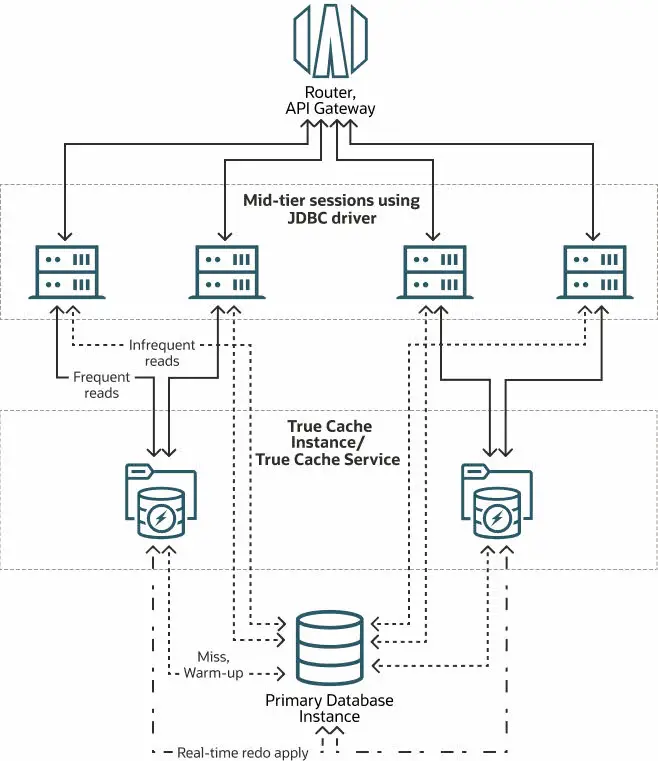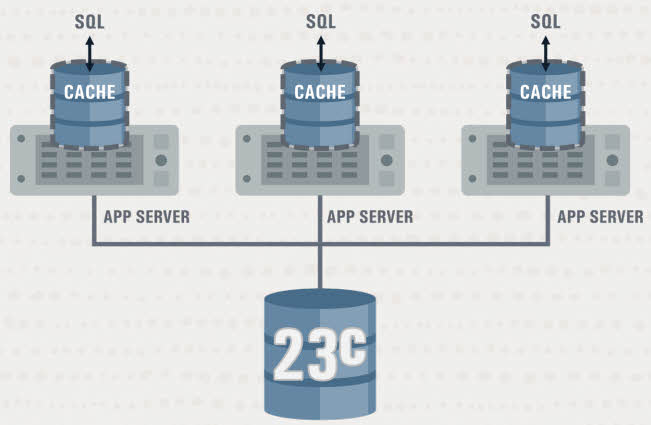True Cache vs. Traditional Caching: A Clear Winner Emerges
In the modern digital world, speed is everything. Instant gratification is what users want, and applications have to deal with heavy workloads and constant traffic. Oracle databases frequently take the brunt of this performance worry because they are the foundation of many important systems. Thankfully, Oracle Database has a powerful tool in its toolbox: True Cache, a cutting-edge in-memory caching solution that can optimize database performance and boost application performance.
But what exactly is True Cache, and how can it transform your Oracle environment? Buckle up, data enthusiasts, as we delve deep into the inner workings of this game-changer, exploring its core features, benefits, and real-world use cases.
True Cache: A Glimpse into the Engine Room
Envision an ultra-fast, continuously available duplicate of your primary database, fully stored in memory and ready to instantly provide commonly requested information. To put it briefly, that is True Cache. Before read requests reach the main database, this read-only, SQL, and key-value cache catches them and serves them straight from its in-memory buffer. Through the elimination of disk I/O delays and a reduction in the burden on the primary database, it delivers an unheard-of speed improvement.
The secret, though, is in the details: that is consistently and automatically handled. Caches that need to be manually configured and synchronized are no more. With built-in invalidation techniques, it easily interacts with your current Oracle database to preserve data consistency. This results in less complicated development, lower operational costs, and a lower chance of data inconsistencies.

Unlocking a Treasure Trove of Benefits
- Blazing-fast Speed: Experience up to 100x faster response times for frequently accessed data. Imagine product pages loading instantly, real-time dashboards updating with a flick of the wrist, and customer service queries resolved in seconds. it makes it a reality.
- Scalability Unleashed: Break free from database bottlenecks. it offloads read requests, enabling your database to handle more concurrent users and data growth without breaking a sweat. Scale your applications with confidence, knowing that has your back.
- DevOps Nirvana: Developers rejoice! True Cache simplifies your life by eliminating the need for complex caching implementation and maintenance. Focus on crafting compelling applications, while True Cache silently optimizes data access in the background.
- Cost-efficiency for the Win: Reduce hardware spend by offloading less-frequent queries to cheaper storage options. True Cache cleverly utilizes memory only for the hottest data, maximizing the value of your existing infrastructure.
- Application Modernization: Breathe new life into legacy applications. That integrates seamlessly with thin clients and databases, streamlining architecture and paving the way for modern enhancements.
Real-World Use Cases
The beauty of True Cache lies in its versatility. It shines in diverse scenarios, from e-commerce giants to high-frequency trading platforms and social media powerhouses. Here are a few examples:
- E-commerce: Imagine customers browsing hundreds of products with zero lag, personalized recommendations appearing on the fly, and checkout processes happening at warp speed. True Cache makes this dream a reality by caching product details, prices, and inventory levels close to the application, delivering a frictionless shopping experience.
- Banking & Finance: Financial institutions rely on lightning-fast data access for real-time trading, fraud detection, and risk analysis. True Cache can cache market data, customer accounts, and transaction histories, enabling rapid decision-making and ensuring market agility.
- Social Media: Millions of users generating endless content require a database infrastructure that can handle the heat. True Cache steps in to cache user profiles, post feeds, and trending topics, ensuring smooth information flow and instantaneous engagement.
Beyond the Hype: Considerations for Successful Implementation
While True Cache is undeniably powerful, its successful implementation requires careful planning and consideration. Here are some key points to remember:
- Identify the right candidates: Not all queries benefit from caching. Analyze your workload and identify frequently accessed, read-heavy operations that are ripe for performance optimization.
- Tune the configuration: It offers options for fine-tuning cache size, invalidation mechanisms, and data selection strategies. Adjust these parameters based on your specific workload and performance requirements.
- Monitor and adapt: It provides comprehensive monitoring tools to track cache hit rates, invalidation events, and overall performance. Continuously monitor and adapt your configuration to ensure optimal efficiency.
Unleashing the Beast: True Cache vs. the In-Memory Database Arena
We’ve extensively explored the inner workings and benefits of True Cache. But in the vast landscape of in-memory databases, how does it stack up against the competition? Let’s dive into a head-to-head comparison with some notable contenders:
1. Redis:
- Strengths: Simple key-value store, lightning-fast performance, ideal for caching small data structures like sessions and shopping carts.
- Weaknesses: Limited data model, lacks SQL support, not suited for complex queries or large datasets.
- Comparison: True Cache offers a more comprehensive SQL-based approach, handling complex queries and larger datasets. While slower than Redis for simple key-value operations, it integrates seamlessly with the ecosystem and provides automatic invalidation, making it a robust choice for enterprise applications.
2. Memcached:
- Strengths: Similar to Redis, excels at caching small data objects, offering exceptional performance and scalability.
- Weaknesses: No database features, lacks persistence and transaction support, unsuitable for complex data scenarios.
- Comparison: True Cache provides a richer feature set with SQL capability, transaction support, and automatic invalidation. It shines in complex applications requiring data consistency and relational operations.
3. Aerospike:
- Strengths: Distributed architecture, horizontally scalable, high availability and fault tolerance, suitable for large datasets and real-time workloads.
- Weaknesses: Complex configuration, custom data persistence required, potentially higher learning curve.
- Comparison: True Cache leverages the existing Oracle infrastructure, simplifying deployment and management. It offers comparable performance for smaller datasets within the ecosystem but might not compete with Aerospike’s scalability for massive, distributed setups.
4. Apache Ignite:
- Strengths: Open-source platform, flexible data model, supports caching, persistence, and distributed processing.
- Weaknesses: Can be resource-intensive, requires skilled operators, lacks deep integration with databases.
- Comparison: True Cache seamlessly integrates with Oracle, simplifying management and leveraging existing expertise. While Apache Ignite offers more flexibility, True Cache excels in optimizing Oracle applications through seamless integration and automatic invalidation.
Remember: The “best” in-memory database depends on your specific needs and environment. It stands out for its seamless integration with Oracle, automatic invalidation, and SQL compatibility, making it a powerful choice for optimizing existing Oracle applications and unlocking their performance potential. However, for specific use cases, like caching small data objects or highly distributed, large-scale deployments, other options might be more suitable.
Ultimately, the decision is yours. Weigh your needs, explore the alternatives, and unleash the data access power that best suits your digital ambitions. With True Cache as a contender, the possibilities are truly electrifying.
Compatibility and Requirements
Ready to harness the power of True Cache? Here’s a quick guide to its availability and requirements:
Database Version Compatibility:
- This feature is exclusively available in Oracle Database 23c and later versions. It’s not supported in earlier releases.

Licensing:
- That is included in the Enterprise Edition. It’s not available in Standard Edition or Express Edition.
Hardware Requirements:
- It thrives on abundant memory. Sufficient RAM is essential to accommodate the in-memory cache and ensure optimal performance.
- A solid-state drive (SSD) is highly recommended for the primary database storage, as it complements True Cache’s speed and responsiveness.
Enabling True Cache:
- Upgrade to 23c version (or a later compatible version).
- Verify that you have the Enterprise Edition license.
- Configure the parameters within the database, specifying the cache size, invalidation strategies, and other relevant settings.
Additional Considerations:
- Application Compatibility: Ensure your applications are compatible with True Cache. Some modifications might be necessary to leverage its benefits fully.
- Monitoring and Tuning: Continuously monitor its performance and adjust its configuration as needed to maintain optimal efficiency.
- Security: Implement appropriate security measures to protect sensitive data stored in True Cache, adhering to best practices for in-memory caching.
Ready, Set, Cache!
By following these guidelines and carefully planning your implementation, you can successfully unleash the power of True Cache and transform your Oracle database into a blazing-fast, highly responsive powerhouse. Embrace the future of data access and experience the remarkable performance gains that True Cache has to offer!
Configuration and Considerations
So, you’ve decided to join the revolution and unlock the hidden potential of your Oracle database. Now comes the exciting (and crucial) step of configuration. But before you dive headfirst into tweaking parameters, let’s explore the intricacies of True Cache configuration and the key considerations for a smooth ride.
Crafting the Perfect Cache:
It offers a robust set of configurable parameters to fine-tune its performance and functionality for your specific needs. Here are some key aspects to focus on:
- Cache Size: This determines the amount of memory allocated to the in-memory buffer. Finding the sweet spot is crucial – too small, and you miss out on caching benefits; too big, and you might starve other vital processes of essential memory. Analyzing your workload and identifying frequently accessed data can help you estimate an optimal cache size.
- Invalidation Strategies: When data in the primary database changes, the cached copy in True Cache needs to be updated to reflect the latest version. That offers different invalidation approaches:
- Read-through: It automatically fetches the latest data on every read request, ensuring data consistency but with slightly higher overhead.
- Periodic refresh: Data is refreshed in the cache at preset intervals, balancing freshness with performance.
- Trigger-based: Specific events in the primary database trigger cache invalidation, providing fine-grained control but requiring careful configuration.
- Data Selection: Not all data benefits from being cached. Choose the right tables and columns to store in True Cache based on their access frequency and size. Excluding large, infrequently accessed data ensures efficient memory utilization.
- Additional Parameters: True Cache offers a range of additional configuration options that influence cache behavior, such as eviction algorithms, logging details, and security settings. Explore these carefully and adjust them based on your specific requirements.
Beyond the Settings: Essential Considerations:
While parameter tweaking is important, remember that successful True Cache implementation goes beyond configuration:
- Application Compatibility: Ensure your applications can leverage True Cache efficiently. JDBC Thin driver usage with read-only logical connections is recommended for seamless integration.
- Monitoring and Tuning: It provides comprehensive monitoring tools. Track cache hit rates, invalidation events, and overall performance to identify optimization opportunities and adjust your configuration as needed.
- Security: Secure your cached data! Implement appropriate access control and encryption measures to protect sensitive information.
- Testing and Validation: Thoroughly test your True Cache configuration with representative workloads to identify potential issues and ensure optimal performance before deploying in production.
Remember: There’s no one-size-fits-all True Cache configuration. The ideal setting depends on your unique database workload, application requirements, and hardware resources. Take your time, experiment, and continuously improve your True Cache setup to experience its full potential.
By approaching True Cache configuration with thoughtful planning, careful adjustment, and a keen eye on performance metrics, you can transform your Oracle database into a lean, mean, data-serving machine. So, roll up your sleeves, dive into the configuration menu, and unleash the True Cache beast within!
Further Reading
Direct NFS: The #1 and Ultimate Network File Storage Solution for Oracle Databases
CPU Core Limit in Oracle Database: Best Solution for Dummies
Network Latency: Best Tools for Measuring










